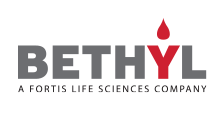Rabbit anti-Huntingtin Antibody Affinity Purified

Product Details
Specifications
The epitope recognized by A302-813A-T maps to a region between residue 2300 and 2350 of human Huntingtin using the numbering given in entry NP_002102.4 (GeneID 3064).
Immunoglobulin concentration was determined using Beer’s Law where 1mg/mL IgG has an A280 of 1.4. Antibody was affinity purified using an epitope specific to Huntingtin immobilized on solid support.
The epitope recognized by A302-813A maps to a region between residue 2300 and 2350 of human Huntingtin using the numbering given in entry NP_002102.4 (GeneID 3064).
Immunoglobulin concentration was determined using Beer’s Law where 1mg/mL IgG has an A280 of 1.4.
Additional Product Information
The Huntingtin (HTT) gene is linked to Huntington's disease, a neurodegenerative disorder characterized by loss of striatal neurons. This is thought to be caused by an expanded, unstable trinucleotide repeat in the huntingtin gene, which translates as a polyglutamine repeat in the protein product. A fairly broad range in the number of trinucleotide repeats has been identified in normal controls, and repeat numbers in excess of 40 have been described as pathological. The huntingtin locus is large, spanning 180 kb and consisting of 67 exons. The huntingtin gene product is widely expressed and is required for normal development [taken from NCBI Entrez Gene (Gene ID: 3064)].
Alternate Names
HD; HD protein; huntingtin; huntington disease protein; IT15; LOMARS
Applications
All western blot analysis is performed using 5% Milk-TBST for blocking and as antibody diluent. Primary antibody is incubated overnight.
Western blots of immunoprecipitates are performed using Goat anti-Rabbit Light Chain HRP Conjugate (Cat. No. A120-113P) with 5% Normal Pig Serum (Cat. No. S100-020) added to the blocking buffer.
